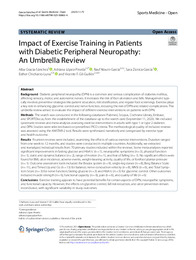Abstract:
Background Diabetic peripheral neuropathy (DPN) is a common and serious complication of diabetes mellitus,
affecting sensory, motor, and autonomic nerves. It increases the risk of foot ulceration and falls. Management typically involves preventive strategies like patient education, risk stratification, and regular foot screenings. Exercise plays a key role in enhancing glycemic control and nerve function, reducing the risk of DPN and related complications. This umbrella review aimed to evaluate the impact of different exercise interventions on patients with DPN.
Methods The search was conducted in the following databases: Pubmed, Scopus, Cochrane Library, Embase,
and SPORTDiscus, from the establishment of the database up to the search date (September 11, 2023). We included systematic reviews and meta-analyses assessing exercise interventions in adults with type 1 or type 2 diabetes and DPN. Studies were selected based on predefined PICO criteria. The methodological quality of included reviews was assessed using the AMSTAR-2 tool. Results were synthesized narratively and categorized by exercise type and health outcome.
Results Fourteen reviews were included, examining the effects of various exercise interventions. Duration ranged from one week to 12 months, and studies were conducted in multiple countries. Additionally, we extracted and reanalyzed individual results from 70 primary studies included within the reviews. Some meta-analyses reported significant improvements in fasting glucose and HbA1c (n = 1), neuropathic symptoms (n = 3), physical function (n = 1), static and dynamic balance (n = 2), range of motion (n = 1), and fear of falling (n = 1). No significant effects were found for BMI, ulcer incidence, adverse events, weight-bearing activity, quality of life, or forefoot plantar pressure (n = 1). Outcome assessment tools included the Biodex system (n = 9), single-leg stance (n = 8), Berg Balance Scale (n = 11), and Timed Up and Go (n = 13) for balance; nerve conduction velocity (n = 8), MNSI (n = 6), and Total Symptom Score (n = 3) for nerve function; fasting glucose (n = 3) and HbA1c (n = 5) for glycemic control. Other outcomes included muscle strength (n = 6), functional capacity (n = 6), pain (n = 6), and quality of life (n = 6).
Conclusions Exercise training appears to have potential benefits for certain aspects of DPN, neuropathic symptoms, and functional capacity. However, the effects on glycemic control, fall risk reduction, and ulcer prevention remain inconclusive, with significant variability in study outcomes.
|

.png)
